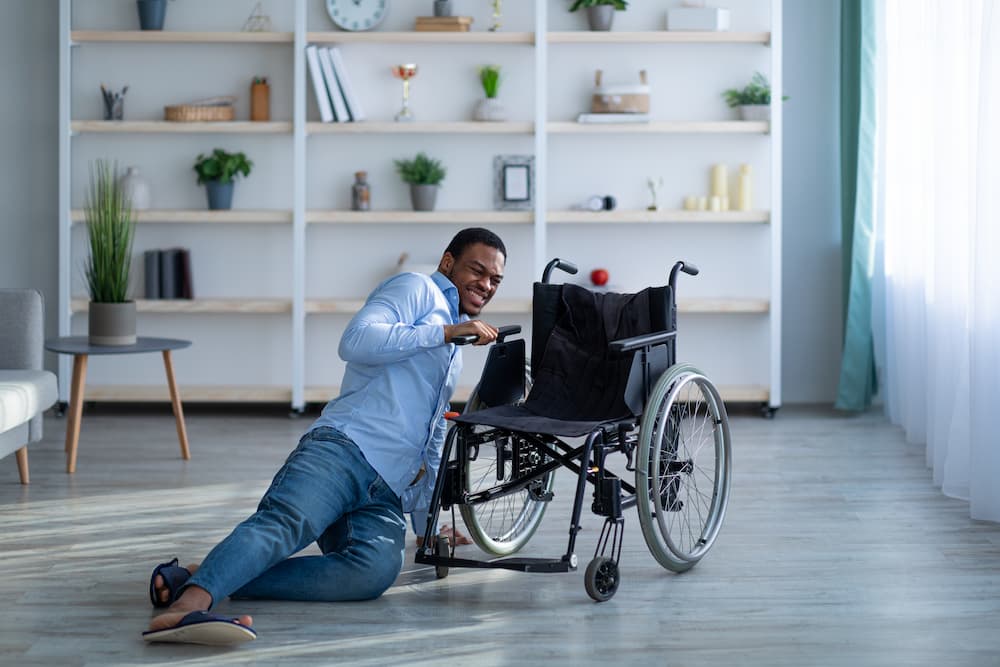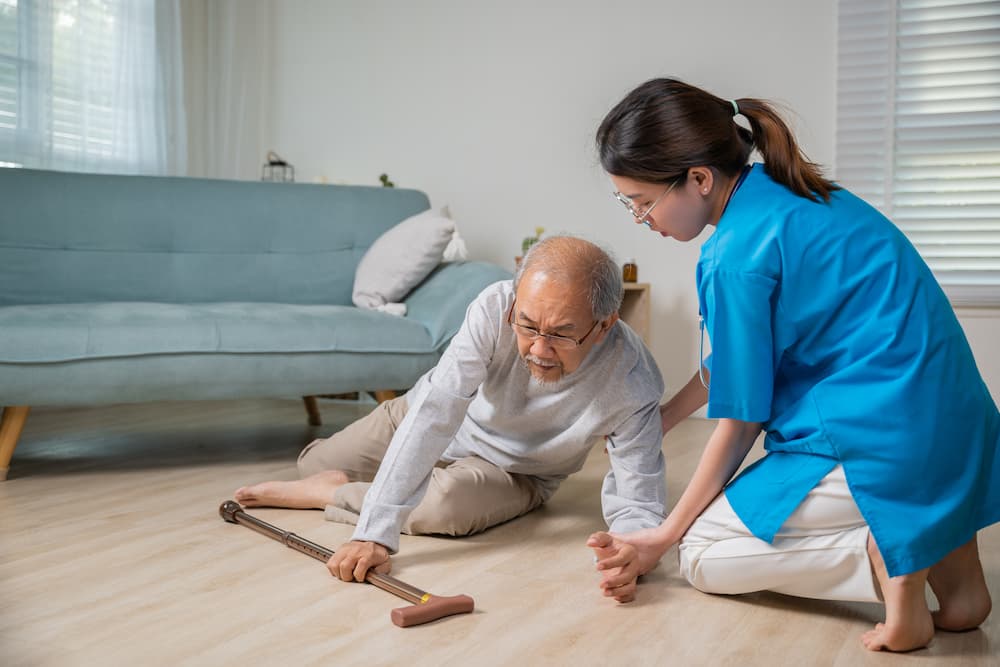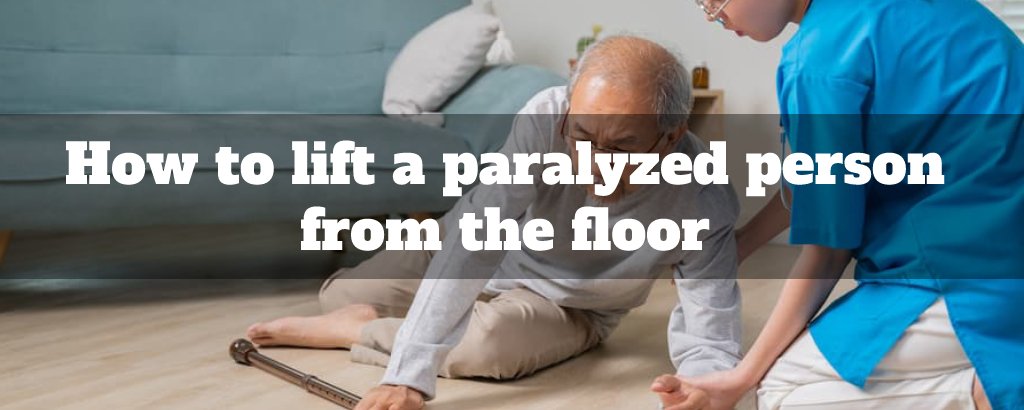Caring for a loved one at home can tax your mental and physical health. You must learn proper lifting techniques to avoid harming yourself and the person you are caring for if they have limited mobility.
This article will discuss how to lift someone paralyzed or with limited movement off the floor.
What happens if a disabled person falls, and what are the consequences
Falling frequently is a problem for those with spinal cord injuries (SCI). According to recent research, 69% of nonambulatory people with SCI experience at least one loss of mobility during the first six to twelve months.
Overall, falls have far-reaching effects, resulting in personal and social burdens. The study tracked the occurrence of common medical issues resulting from falling.
- Pressure ulcer. A pressure ulcer is a region of the skin or underlying soft tissue that has been damaged due to high or prolonged pressure, manifested by redness and ulceration.
- Neurogenic pain: Pain that originates in the nervous system, such as numbness, tingling, coldness, warmth, sweat, girdle-zone pain, and phantom sensations at or below the lesion level.
- Movement restriction: Caused by the shortening or contracture of connective tissues, joint capsules, muscles, and tendons surrounding the joints.
- Musculoskeletal pain: Also known as nociceptive pain, is the discomfort felt in the bones, joints, or muscles due to damage or overuse.
- Autonomic dysreflexia: A sympathomimetic reaction to a stimulation below the level of SCI, manifested by symptoms such as hypertension, sweating above the level of the lesion, nasal stuffiness, or headache necessitating therapeutic intervention other than sitting the individual up to lower hypertension.
- Problems with breathing: Such as dyspnea and slowed breathing.

Other problems were also recorded with medical documentation or physician verification; these include
- heterotopic ossification
- Osteoporosis
- Fracture
- renal calculi
- UTI and DVT
When A Disabled Person Falls, Who To Call?

You should usually dial 911 for assistance if a paralyzed person falls.
To get the disabled person to the hospital quickly, please treat the following as true emergencies:
- Severe bleeding in a paralyzed person.
- If they have sustained significant bruises.
- They’re in so much anguish that they’re wailing.
- If they can’t express themselves adequately.
- If the person is unconscious or has sporadic periods of awareness.
In these circumstances, it’s best to be a little overcautious, even if it turns out that their damage wasn’t as severe as initially thought.
Lifting techniques
According to the Bureau of Labour Statistics, the incident rate for overexertion and body reaction among nurses was five times greater in 2014 than it was across most other industries. Even professionally educated nurses frequently suffer injuries.
Caregivers should learn several lifting techniques to handle disabled or paralyzed individuals.
When lifting or moving a paralyzed person, following general rules should be followed:
- Maintain a straight back, neck, and head. Your head, neck, and spine should be in good alignment.
- Keep your spine’s natural curve; bend from your hips and knees rather than your back.
- When carrying someone, avoid twisting your body.
- Keep the person being moved close to your body at all times.
- For balance, keep a distance between your feet of around shoulder-width.
- To raise or pull, utilize the leg muscles.
- Get assistance if the person is unwilling, weighty, or awkward.
How to Get a Paralyzed Person Off the Floor
Be patient and empathetic if you try to help someone off the floor after falling; they may be dazed, bewildered, or hurt.
- Check for injuries before attempting to help someone up from the floor.
- Be careful not to overextend an injured arm or leg, as doing so increases the risk of breaking or fracturing the internal muscles or bones.
- If someone has fallen, put a chair under their feet and another under their head. Ensure that both seats are secure and won’t roll away.
- If the paralyzed person falls near some chairs or a sofa, you can utilize those items to assist them in getting up.
- Start by bending at the knees and gently rolling the person onto their side.
- As soon as the paralyzed person is lying on their side, gently assist them into a kneeling position. When a person’s knees need extra support, a pillow can be tucked between them.
- Have a chair ready and let them lean against the back of the chair in front of you.
- Assist the user in performing a knee-lunge-like movement toward the chair by raising just one leg.
- Make sure you can sit or stand securely on any surrounding furniture. If you’re using the two-chair method, move the second chair so it’s closed behind the person hanging on. Then, help them ease into sitting in the chair behind them.
Keeping yourself calm and calling 911 is the best action if you cannot help a paralyzed person up from the floor or if they are in extreme pain.
How to raise a paralyzed person from an outdoor Fall
Many things could hurt you outdoors, like uneven pavement, pebbles that stick out, slick grass, and black ice.
An outdoor fall by a loved one with a disability requires extra care to get them back on their feet. Since injuries sustained in the outdoors might be life-threatening, you should check them out first.
If they don’t have any severe injuries to their head, neck, or back, you should try to move them away from any sharp objects they might encounter on the ground, such as ice, grass, or rocks.
Ensure the ground is solid enough to support them (maybe by bringing some chairs out from the kitchen or the patio). In the absence of such precautions, they run the risk of falling again.
After that, you can change the steps in this post to fit your particular needs.
Equipment that can assist in lifting a paraplegic person off the floor
An emergency lifting device is another alternative for getting someone off the ground. There are two categories of tools available to you.
- Lifting Cushions
- Portable Lifts (aka Hoyer Lifts).
Lifting Cushions
After a fall, the caregiver can use these cushions to gently pull the patient into a sitting position without having to work hard or make a lot of trouble.
Make sure to select a lifting cushion rated for the weight of the person you will be supporting.
Check out this video to learn how these lifting cushions work.
- The air mattress
A particularly effective option is an air mattress. Roll the individual lying on the floor onto the deflated mattress, and then start inflating it to bring them into a sitting position.
Check out this video to learn how air mattresses lift people off the floor.
- Inflatable chair
A chair that you can inflate with air would be another comparable option. It would be utilized similarly to an air mattress.
Watch the video below to learn how an inflatable chair is used to raise people off the ground.
These two alternatives will be less expensive than a genuine lifting cushion, but remember that they weren’t made for this use, so they could not function well or last as long.
Patient lifts
Patient lifts can help lift people off the ground and are also called “Hoyer lifts.”
It is essential to know that not all patient lifts have this feature. Some have limited lifting ranges and can’t reach someone lying on the floor.
You should consider what qualities are most important to you in your scenario before choosing a patient lift among the variety of available designs.
The most affordable option is usually a manual lift, whereas electric lifts are a little simpler to use and require less physical work from the caregiver.
Watch this video and see how these patient lifts are utilized for lifting patients from the floor.
The Human Floor Lift by Indeelift
The Indeelift human floor lift is used mainly in hospitals, nursing homes, assisted living institutions, and rehab centers.
A lift is placed beneath the fallen person to raise them to a seated position so they can stand independently.
Watch this video to see how this indeed lift functions.
This video shows how to lift a patient off the floor.
The patient is being helped to roll to one side in this video.
As the patient adjusts their position to kneel on one knee, gentle support is given while assisting him in a kneeling position.
After that, the helper rests the patient’s arms on the chair’s seat.
Helper brings a second non-rolling chair over to the patient after he is in a solid position, and the patient puts their arms on the chair in front of them.
A helper helps the patient push up to standing by gently using their arms and legs. As the patient carefully sits in the chair behind them, the helper supports his back.
This video shows how to transfer a stroke patient from a bed to a wheelchair.
A helper places the opposite paralyzed arm on the patient’s body and moves it closer to him, away from the patient’s body.
Next, the helper bends the opposite knee with one hand on the pelvis and the other on the patient’s shoulder blade.
The helper brings the legs off the bed, stabilizes the patient’s hip with one hand, and pulls the patient to a sitting position with both feet flat on the floor.
Next, he places a chair near the patient’s strong arm to ensure the brakes remain activated.
Then he lifts the buttocks, bends his knees, and keeps his back straight to shift the patient onto the chair.
Before you go
You may wonder what happens to the brain when the spinal cord is injured. We’ve covered the topic in detail on our blog. We’ve also covered how a spinal cord injury affects the body. Take a look to learn more.

